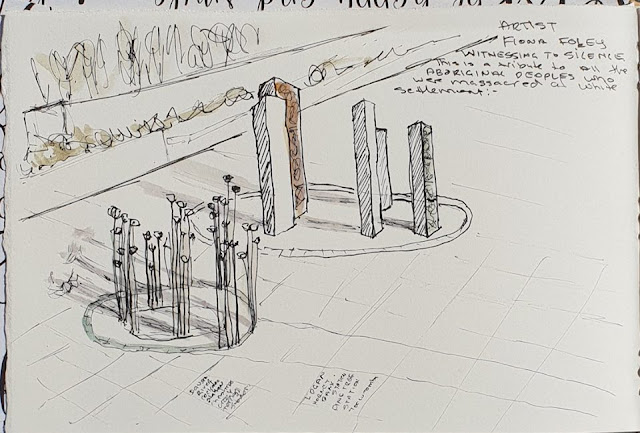Biomechanical Pelicans sculpture created by Christopher Trotter in 1995.
These pelicans are made from found metal from all sorts of things,
machinery of all kinds. Christopher Trotter is a prominent local metal
artist. They sit upon an historic pylon from the early days when the
river was a thriving shipping trade. This was in the 1860s All along
kangaroo Point Cliffs there were wharves for the ships.
In the
early 1860s the river was not deep enough for these big sailing and
steam ships to enter up river, so it was dredged. The dredging was
extensive, and changed the river considerably. They had to dredge all
the way up to Brisbane Town, no mean feat in those days. It took many,
many years to dredge the river to make it deep enough for the big ships,
and when it was suitable of course wharves were needed.
The history of wharves along the Brisbane River can be categorised into a number of stages:
Stage One - A tree trunk at South Brisbane to which ships were moored in the 1840s.
Stage Two - The erection of wharves for commerce. These eventually extended along the river bank at South Brisbane (eg. South Brisbane Coal Wharves), along the Town Reach to Customs House and then downstream along the Bulimba Reach to Breakfast Creek.
Stage One - A tree trunk at South Brisbane to which ships were moored in the 1840s.
Stage Two - The erection of wharves for commerce. These eventually extended along the river bank at South Brisbane (eg. South Brisbane Coal Wharves), along the Town Reach to Customs House and then downstream along the Bulimba Reach to Breakfast Creek.
Stage Three - The opening of a dock and the further development of
docks. This did not occur in the Brisbane River as the river is not wide
enough for ships to swing into transverse berths at jetty peninsulas.
Stage Four - Specialised quayage developed early in the river's history, with some examples as follows: New Farm Sugar Refinery Wharf (1893), Pinkenba Wharf for meat exports (1902), Amoco and Ampol Oil Terminals and more recently, the specialised facilities for the Port of Brisbane at the mouth of the river.
Stage Four - Specialised quayage developed early in the river's history, with some examples as follows: New Farm Sugar Refinery Wharf (1893), Pinkenba Wharf for meat exports (1902), Amoco and Ampol Oil Terminals and more recently, the specialised facilities for the Port of Brisbane at the mouth of the river.
The largest ship built on the river was the Robert Miller, a 66,000 tonne vessel.
From 1862 the Brisbane River has been dredged for navigation purposes.
The river served as an important carriageway between Brisbane and Ipswich
before a railway linking the towns was built in 1875. By the late
1920s, water quality in the river had significantly deteriorated. Dredging was banned in the river in 1967.
Sketched in my 6" x 8" handmade sketchbook with mechanical pencil and watercolour.























